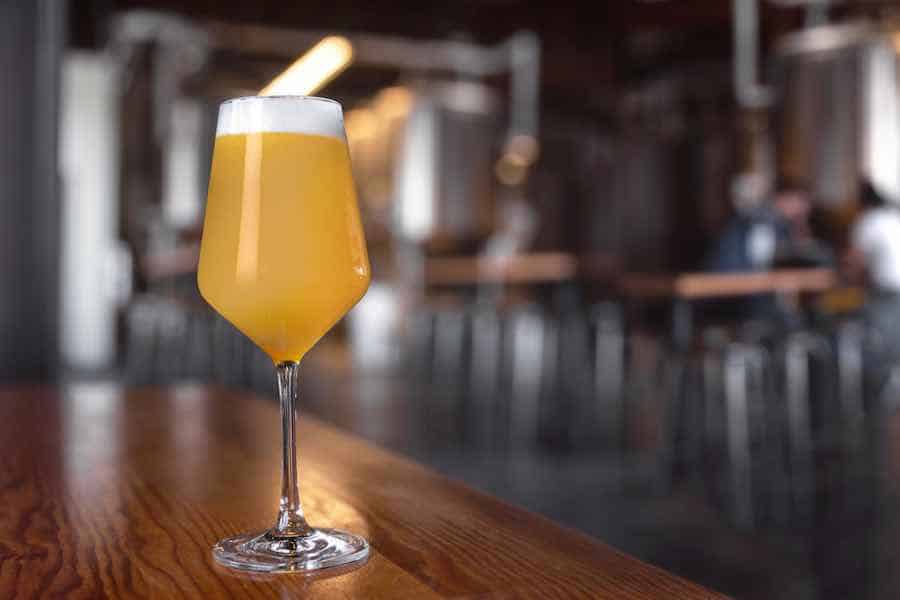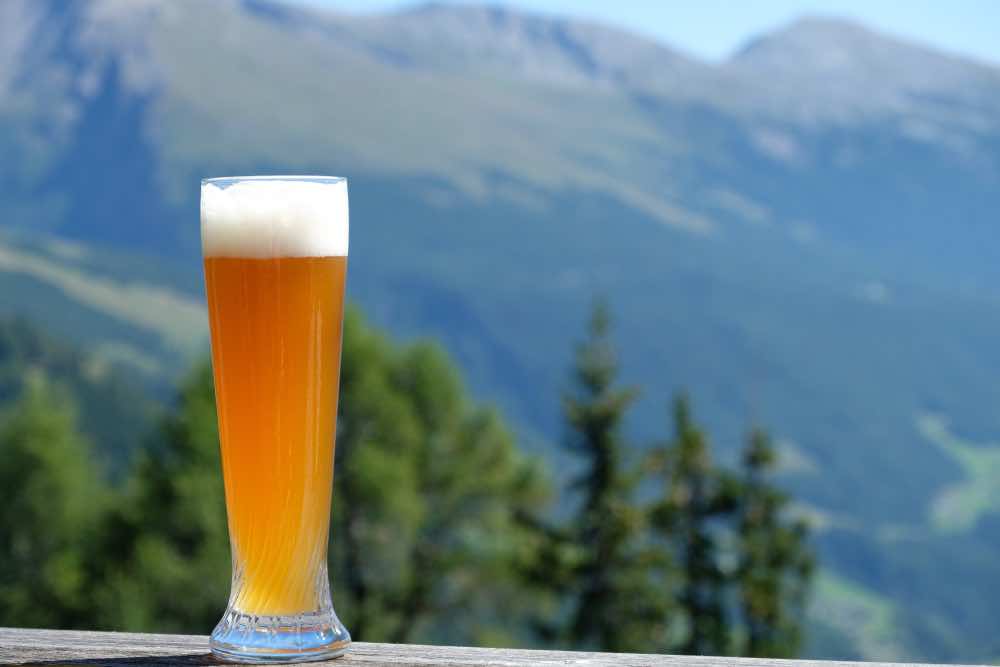If you’re just getting into drinking beer, then you’re probably not familiar with Hefeweizen beer yet. Hefweizen, which is a personal favorite of mine, is a type of German wheat beer that comes from Bavaria, Germany.
If you break down the name itself, you’ll understand a bit more about Hefeweizen Beer: Hefe in German means “yeast” and weizen means “wheat”. Basically, it is an unfiltered wheat beer that has yeast in it; which is responsible for giving it a hazy look. Both ingredients also add additional bitterness to the flavor of the beer, and really set it apart from other ales. If you want to know more about Hefeweizen beer, read on:
History of Hefeweizen Beer
Originating in Bavaria, Germany, Hefeweizen has been around since the 1520s. Despite some hard times it is one of the most popular beers in the world.
In 1487 Germany proposed a “Purity Law” that caused problems for the Hefeweizen. It stated the only ingredients allowed in beer were barley, hops, and water. Unfortunately for Hefeweizen it’s main ingredient, yeast, was not included.
The Purity Law was designed so that bread makers interested in brewing beer would be able to afford and access the inexpensive ingredients needed. This law helped to stop brewers from using unsafe “concoctions” to preserve their beers. Foreign beers were unable to be imported to Germany because they also couldn’t meet the standards that this law set.
Bavaria also adopted the Purity Law in 1516. This increasingly popular regulation was starting to cause problems in the beer industry. More and more breweries were moving to a mix of just barley, hops, and water. This combination created a lower quality beer that tastes bad. To combat this and fight back some breweries started experimenting with new ingredients to add to the flavor.
This beer maker’s rebellion birthed Weissbier, a very popular brew. It got its tasty flavor from the malted wheat and malted barley that was added. The royals at the time loved this brew so much that in the 1520s they created a mandate to allow one brewery in Bavaria to brew it.
Over time more and more breweries began opening up and contributed to the popularity of Weissbier. The entire operation was controlled by the Wittelbachs in the village of Schwarzach.
Hefeweizen started to become unpopular in the 1700s because dark lagers were coming back. Since people were starting to prefer other types of beer the Wittelbachs decided that holding the exclusive rights to Weissbier was no longer worth it. Finally in 1778 the laws were changed allowing anyone to brew the beer. Despite their efforts though it did not become popular again.
By 1812 there were only two breweries left in Bavaria brewing the Weissbier. The failing businesses were eventually sold to George Schneider in 1856. This turned out to be a great business move and in the mid-1900s the beer became popular again and his brewery G. Shneider & Sons made the most popular beer in the world.
How Hefeweizen Beer Differs From Other Wheat Ales
Wheat beer is exactly what it sounds like, a beer made with mostly wheat, usually 50-70%. The rest of the beer is made up of mostly barley malt. There are a lot of varieties of wheat beers on the market including Belgian wheat and German Weissbier.
German Weissbier is categorized based on the proportion of wheat, hops, and yeast it contains. There are four categories: Kristallweizen, Dunkelweizen, Weizenbock, and Hefeweizen.
Kristallweizen is a very clear beer due to its heavy filtering. The name Kristallweizen means “clear wheat”. Dunkelweizen is very dark and bready, it is brewed with dark malts. Weizenbock is a hearty wheat German lager. It has very little hop flavor and is malty and sweet with a high alcohol content.
Of all of the Hefeweizen beers, Weissbier is the most popular. It is known for its cloudy and white appearance as it is unfiltered. The brewer’s yeast remains left suspended in the beer. The smell is fruity and spicy with a refreshing flavor that has notes of vanilla, clove, and banana.
Hefeweizen vs. Pilsner
The Purity Law, established in 1516, forbade brewers from making Weissbiers due to the ingredients. They became so popular among the royalty however that they received a special exemption from this law.
Weissbier (white beer) was used to describe German beers that were pale in color. Hefeweizen was a very early beer creation coming long before pale ale and lager. Hefe means yeast and weizen means wheat.
Weissbier is made of at least 50% wheat malt but some can be higher. It is made with a “top-fermentation” style that makes it a crisp, easy to drink ale. The yeast is suspended giving the beer it’s cloudy look and has a lower alcohol content.
Unlike Weissbier, German pilsner is “bottom-fermented” and a lager. It has some similarities to Weissbier. German pilsners are also pale colored, crisp tasting, and have a foamy white head. The pilsner’s sweet taste comes from the malts whereas the Hefeweizen’s sweetness comes from the wheat. Pilsners are more hoppy and bitter and noticeably clear and filtered.
Hefeweizens are heavy and full bodied with high carbonation. While they are widely produced by brewers they also can be distinct in flavor. Some are classically sweet and fruity while some can have undertones of vanilla or even bubblegum.
German laws regarding beer production are more strict than American laws. This means that American breweries have more flexibility in the ingredients they use and how they obtain certain flavor profiles. Some use other types of yeast, spices, and citrus.
American vs. German Hefeweizen
Hefeweizen originated in Germany and was brought to America by German immigrants making it popular in America.
American Hefeweizen isn’t bound by many of the constraints as German Hefeweizen so the flavors vary widely. The American yeasts used to make Hefeweizen make this type of beer more malty.German brewers use little to no hops. They also have more wheat than American Hefeweizen.
How to Drink Hefeweizen Properly
When enjoying a Hefeweizen or other wheat beer you have to do it right. Use a tulip shaped glass which has a narrow base, open middle, and narrows at the top. This shape helps form a perfect head as it is poured. It is also best if served cold.
Many Americans who drink Hefeweizen garnish it with lemon. While some people say this actually ruins the “real” taste of the beer and the perfect head, others think that it’s tartness pairs perfectly with the beer.

Pairing it With Food
Hefeweizens have a flavor profile that naturally pairs well with a variety of foods including German classics like weisswurst. They are also a great partner with pizza, seafood, and smoky pork.
Hefeweizens are very versatile and can be served or enjoyed with beets, smoky flavors, BBQ, and even spicy Indian or Mexican dishes. Try it with your dessert course if you are having something fruity like key lime pie. Avid beer drinkers recommend not pairing this beer with berries.
Top Hefeweizen Brands
While you can brew Hefeweizens at home, you can also purchase some to drink immediately. Hefeweizens are very easy to find and produced by many of the largest beer companies. Here are some recommendations we have for types to try:

